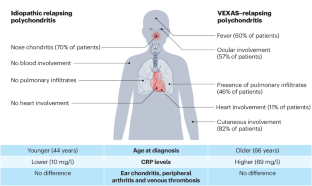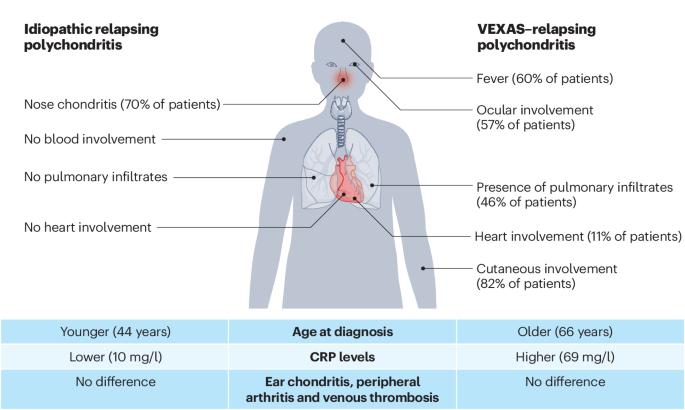Relapsing polychondritis: clinical updates and new differential diagnoses
IF 29.4
1区 医学
Q1 RHEUMATOLOGY
引用次数: 0
Abstract
Relapsing polychondritis is a rare inflammatory disease characterized by recurrent inflammation of cartilaginous structures, mainly of the ears, nose and respiratory tract, with a broad spectrum of accompanying systemic features. Despite its rarity, prompt recognition and accurate diagnosis of relapsing polychondritis is crucial for appropriate management and optimal outcomes. Our understanding of relapsing polychondritis has changed markedly in the past couple of years with the identification of three distinct patient clusters that have different clinical manifestations and prognostic outcomes. With the progress of pangenomic sequencing and the discovery of new somatic and monogenic autoinflammatory diseases, new differential diagnoses have emerged, notably the vacuoles, E1 enzyme, X-linked, autoinflammatory, somatic (VEXAS) syndrome, autoinflammatory diseases and immune checkpoint inhibitor-related adverse events. In this Review, we present a detailed update of the newly identified clusters and highlight red flags that should raise suspicion of these alternative diagnoses. The identification of these different clusters and mimickers has a direct impact on the management, follow-up and prognosis of patients with relapsing polychondritis and autoinflammatory syndromes. Relapsing polychondritis, a rare inflammatory disorder that affects cartilaginous structures, presents challenges in diagnosis owing to overlapping symptoms with other conditions. This Review provides a clinical update on relapsing polychondritis, emphasizing the importance of distinguishing this disease from similar conditions.


复发性多软骨炎:临床更新和新的鉴别诊断
复发性多软骨炎是一种罕见的炎症性疾病,其特点是软骨结构(主要是耳朵、鼻子和呼吸道)反复发炎,并伴有广泛的全身特征。尽管复发性多软骨炎非常罕见,但及时识别和准确诊断复发性多软骨炎对于适当的治疗和取得最佳疗效至关重要。过去几年中,我们对复发性多软骨炎的认识发生了显著变化,发现了三个不同的患者群,它们具有不同的临床表现和预后结果。随着泛基因组测序的进展以及新的体细胞性和单基因自身炎症性疾病的发现,出现了新的鉴别诊断,特别是空泡、E1酶、X连锁、自身炎症、体细胞性(VEXAS)综合征、自身炎症性疾病和免疫检查点抑制剂相关不良事件。在本《综述》中,我们详细介绍了新发现的疾病群的最新情况,并强调了应引起对这些替代诊断怀疑的警示。识别这些不同的群集和模仿者对复发性多软骨炎和自身炎症综合征患者的管理、随访和预后有直接影响。
本文章由计算机程序翻译,如有差异,请以英文原文为准。
求助全文
约1分钟内获得全文
求助全文
来源期刊

Nature Reviews Rheumatology
医学-风湿病学
CiteScore
29.90
自引率
0.90%
发文量
137
审稿时长
6-12 weeks
期刊介绍:
Nature Reviews Rheumatology is part of the Nature Reviews portfolio of journals. The journal scope covers the entire spectrum of rheumatology research. We ensure that our articles are accessible to the widest possible audience.
 求助内容:
求助内容: 应助结果提醒方式:
应助结果提醒方式:


